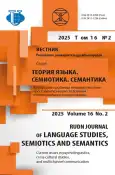A Corpus-Based Study of Vocabulary Distribution in Omani High School English Textbooks
- Authors: Pathan H.1,2, Aleksandrova O.I.2, Alvi U.F.3, Khalid M.3
-
Affiliations:
- Sohar University
- RUDN University
- University of Education
- Issue: Vol 16, No 2 (2025): Current issues in psycholinguistics, cross-cultural studies, and multichannel communication
- Pages: 543-555
- Section: FUNCTIONAL SEMANTICS
- URL: https://journal-vniispk.ru/2313-2299/article/view/323529
- DOI: https://doi.org/10.22363/2313-2299-2025-16-2-543-555
- EDN: https://elibrary.ru/FKNRUZ
- ID: 323529
Cite item
Full Text
Abstract
Lexical make-up of the revised Engage with English textbooks utilized in Omani high schools for grades 11 and 12 are under examination. The textbooks were examined through a corpus-based methodology, employing the Vocabulary Profiler to classify terms put on the General Service List (GSL), the Academic Word List (AWL), and off-list vocabulary. The results indicate that the textbooks develop foundations in high-frequency vocabulary, they may inadequately prepare students to master Academic English, particularly due to the limited inclusion of AWL terms and the excessive presence of off-list vocabulary. These findings underscore the necessity of employing a balanced vocabulary strategy in textbook design to guarantee that students cultivate both communicative and academic competencies. Our study has some implications for English language teaching in Oman and recommendations for enhancing vocabulary training.
About the authors
Habibullah Pathan
Sohar University; RUDN University
Author for correspondence.
Email: Hpathan@su.edu.om
ORCID iD: 0000-0003-3425-3594
Scopus Author ID: 57221613434
ResearcherId: AAV-7602-2020
PhD in Philology, Research Professor of the Faculty of Language Studies, Sohar University; senior researcher of the Faculty of Philology, RUDN University
Al Jameah str., Sohar, Al-Batinah, Oman, 3111; 6, Miklukho-Maklaya str., Moscow, Russian Federation, 117198Oksana I. Aleksandrova
RUDN University
Email: alexandrova-oi@rudn.ru
ORCID iD: 0000-0002-7246-4109
SPIN-code: 1858-5107
Scopus Author ID: 57200073938
ResearcherId: Q-7339-2016
PhD in Philology, Associate Professor, Associate Professor of the General and Russian Linguistics Department of the Faculty of Philology
6 Miklukho-Maklaya st., Moscow, Russian Federation, 117198Urooj F. Alvi
University of Education
Email: Urooj.alvi@ue.edu.pk
ORCID iD: 0000-0002-8545-0136
SPIN-code: 9799-0555
PhD in Philology, Assistant Professor of the Department of English of the Division of Arts and Social Sciences
Rati Gun Rd, Lower Mall, Data Gunj Buksh Town, Lahore, Punjab, Pakistan, 54000Muhammad Khalid
University of Education
Email: ksdoshi786@gmail.com
ORCID iD: 0009-0004-9402-6582
SPIN-code: 6582-6230
PhD student, teacher at school education department
Rati Gun Rd, Lower Mall, Data Gunj Buksh Town, Lahore, Punjab, Pakistan, 54000References
- Baker, P. (2023). A year to remember? Introducing the BE21 corpus and exploring recent part of speech tag change in British English. International Journal of Corpus Linguistics, 28(3). 407–429. https://doi.org/10.1075/ijcl.22007.bak EDN: TLFOYC
- Laufer, B., & Nation, P. (1995). Vocabulary size and use: Lexical richness in L2 written production. Applied Linguistics, 16(3), 307–322. https://doi.org/10.1093/applin/16.3.307 EDN: ILBAMH
- Schmitt, N. (2000). Vocabulary in language teaching. Cambridge: Cambridge University Press.
- Qian, D.D. (2002). Investigating the relationship between vocabulary knowledge and academic reading performance: An assessment perspective. Language Learning, 52(3), 513–536. https://doi.org/10.1111/1467-9922.00193
- Woodin, G., Winter, B., Littlemore, J., Perlman, M. & Grieve, J. (2024). Large-scale patterns of number use in spoken and written English. Corpus Linguistics and Linguistic Theory, 20(1), 123–152. https://doi.org/10.1515/cllt-2022-0082 https://doi.org/10.1515/cllt-2022-0082 EDN: YOASAW
- Nation, I.S.P. (2001). Learning vocabulary in another language. Cambridge: Cambridge University Press. https://doi.org/10.1017/CBO9781139524759
- West, M. (1953). A general service list of English words. London: Longman, Green.
- Nation, I.S. P., & Waring, R. (1997). Vocabulary size, text coverage and word lists. In: N. Schmitt & M. McCarthy (Eds.), Vocabulary: Description, acquisition and pedagogy (pp. 6–19). Cambridge: Cambridge University Press.
- Milton, J., & Alexiou, T. (2009). Vocabulary size and the Common European Framework of References for Languages. In: B. Richards, H. Daller, D. Malvern, P. Meara, J. Milton, & J. Treffers-Daller (Eds.), Vocabulary studies in first and second language acquisition: The interface between theory and application (pp. 194–211). London: Palgrave Macmillan. https://doi.org/10.1057/9780230242258_12
- Coxhead, A. (2000). A new academic word list. TESOL Quarterly, 34(2), 213–238. https://doi.org/10.2307/3587951
- Nation, I.S.P. (2006). How large a vocabulary is needed for reading and listening? Canadian Modern Language Review, 63(1), 59–82. https://doi.org/10.3138/cmlr.63.1.59
- Schmitt, N., & Schmitt, D. (2014). A reassessment of frequency and vocabulary size in vocabulary teaching. Language Teaching, 47(4), 484–503. https://doi.org/10.1017/S0261444812000018
- Meara, P. (2005). Lexical frequency profiles: A Monte Carlo analysis. Applied Linguistics, 26(1), 32–47. https://doi.org/10.1093/applin/amh037 EDN: ILAOPV
- Laufer, B. (1992). How much lexis is necessary for reading comprehension? In: H. Béjoint & P. Arnaud (Eds.), Vocabulary and applied linguistics (pp. 126–132). London: Macmillan. https://doi.org/10.1007/978-1-349-12396-4_12
- Cobb, T. (2007). Computing the vocabulary demands of L2 reading. Language Learning & Technology, 11(3), 38–63.
- Shamsuddin, C.M., & Hamid, B.A. (2017). Representational Meanings of Gender Stereotyped Professional Occupation Images in Selected Malaysian English Language Textbooks. 3L: Language, Linguistics, Literature® The Southeast Asian Journal, 23(4), 136–156. http://doi.org/10.17576/3L-2017-2304-10
- Kawai, T. (2014). Vocabulary coverage and its implication for learners of English. Journal of English Teaching, 3(1), 58–73.
- Chen, Q., & Ge, G.C. (2007). A corpus-based lexical study on frequency and distribution of Coxhead’s AWL word families in medical research articles (RAs). English for Specific Purposes, 26(4), 502–514. https://doi.org/10.1016/j.esp.2007.04.003
- Schmitt, N. (2008). Review article: Instructed second language vocabulary learning. Language Teaching Research, 12(3), 329–363. https://doi.org/10.1177/1362168808089921 EDN: JOJLAB
- Webb, S. (2009). The effects of receptive and productive learning of word pairs on vocabulary knowledge. RELC Journal, 40(3), 360–376. https://doi.org/10.1177/0033688209343854
Supplementary files









